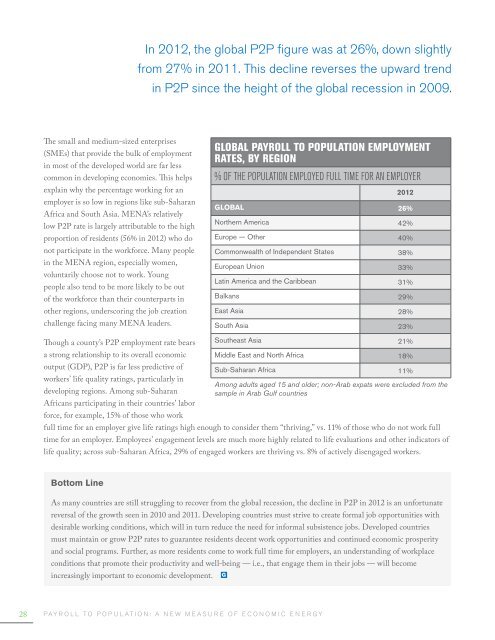GlobalWorkplaceReport_2013
GlobalWorkplaceReport_2013
GlobalWorkplaceReport_2013
Create successful ePaper yourself
Turn your PDF publications into a flip-book with our unique Google optimized e-Paper software.
In 2012, the global P2P figure was at 26%, down slightly<br />
from 27% in 2011. This decline reverses the upward trend<br />
in P2P since the height of the global recession in 2009.<br />
The small and medium-sized enterprises<br />
(SMEs) that provide the bulk of employment<br />
in most of the developed world are far less<br />
common in developing economies. This helps<br />
explain why the percentage working for an<br />
employer is so low in regions like sub-Saharan<br />
Africa and South Asia. MENA’s relatively<br />
low P2P rate is largely attributable to the high<br />
proportion of residents (56% in 2012) who do<br />
not participate in the workforce. Many people<br />
in the MENA region, especially women,<br />
voluntarily choose not to work. Young<br />
people also tend to be more likely to be out<br />
of the workforce than their counterparts in<br />
other regions, underscoring the job creation<br />
challenge facing many MENA leaders.<br />
Global Payroll to Population Employment<br />
Rates, by Region<br />
% of the population employed full time for an employer<br />
2012<br />
GLOBAL 26%<br />
Northern America 42%<br />
Europe — Other 40%<br />
Commonwealth of Independent States 38%<br />
European Union 33%<br />
Latin America and the Caribbean 31%<br />
Balkans 29%<br />
East Asia 28%<br />
South Asia 23%<br />
Though a county’s P2P employment rate bears<br />
a strong relationship to its overall economic<br />
output (GDP), P2P is far less predictive of<br />
Southeast Asia<br />
Middle East and North Africa<br />
Sub-Saharan Africa<br />
21%<br />
18%<br />
11%<br />
workers’ life quality ratings, particularly in<br />
Among adults aged 15 and older; non-Arab expats were excluded from the<br />
developing regions. Among sub-Saharan<br />
sample in Arab Gulf countries<br />
Africans participating in their countries’ labor<br />
force, for example, 15% of those who work<br />
full time for an employer give life ratings high enough to consider them “thriving,” vs. 11% of those who do not work full<br />
time for an employer. Employees’ engagement levels are much more highly related to life evaluations and other indicators of<br />
life quality; across sub-Saharan Africa, 29% of engaged workers are thriving vs. 8% of actively disengaged workers.<br />
Bottom Line<br />
As many countries are still struggling to recover from the global recession, the decline in P2P in 2012 is an unfortunate<br />
reversal of the growth seen in 2010 and 2011. Developing countries must strive to create formal job opportunities with<br />
desirable working conditions, which will in turn reduce the need for informal subsistence jobs. Developed countries<br />
must maintain or grow P2P rates to guarantee residents decent work opportunities and continued economic prosperity<br />
and social programs. Further, as more residents come to work full time for employers, an understanding of workplace<br />
conditions that promote their productivity and well-being — i.e., that engage them in their jobs — will become<br />
increasingly important to economic development.<br />
28 PAYROLL TO POPULATION: A NEW MEASURE OF ECONOMIC ENERGY


